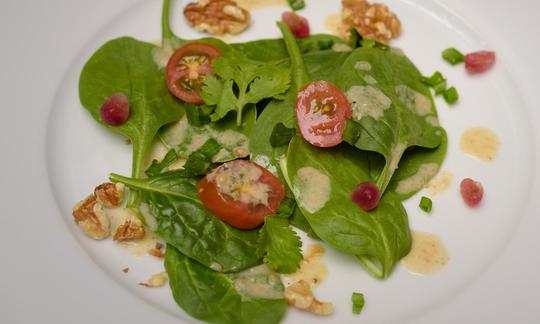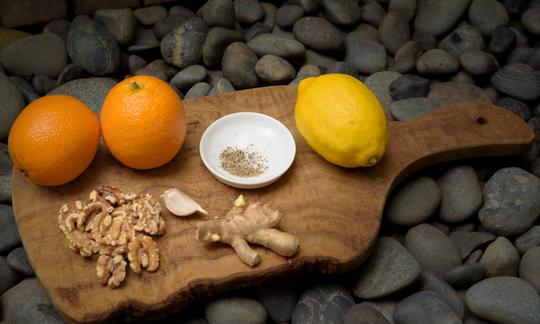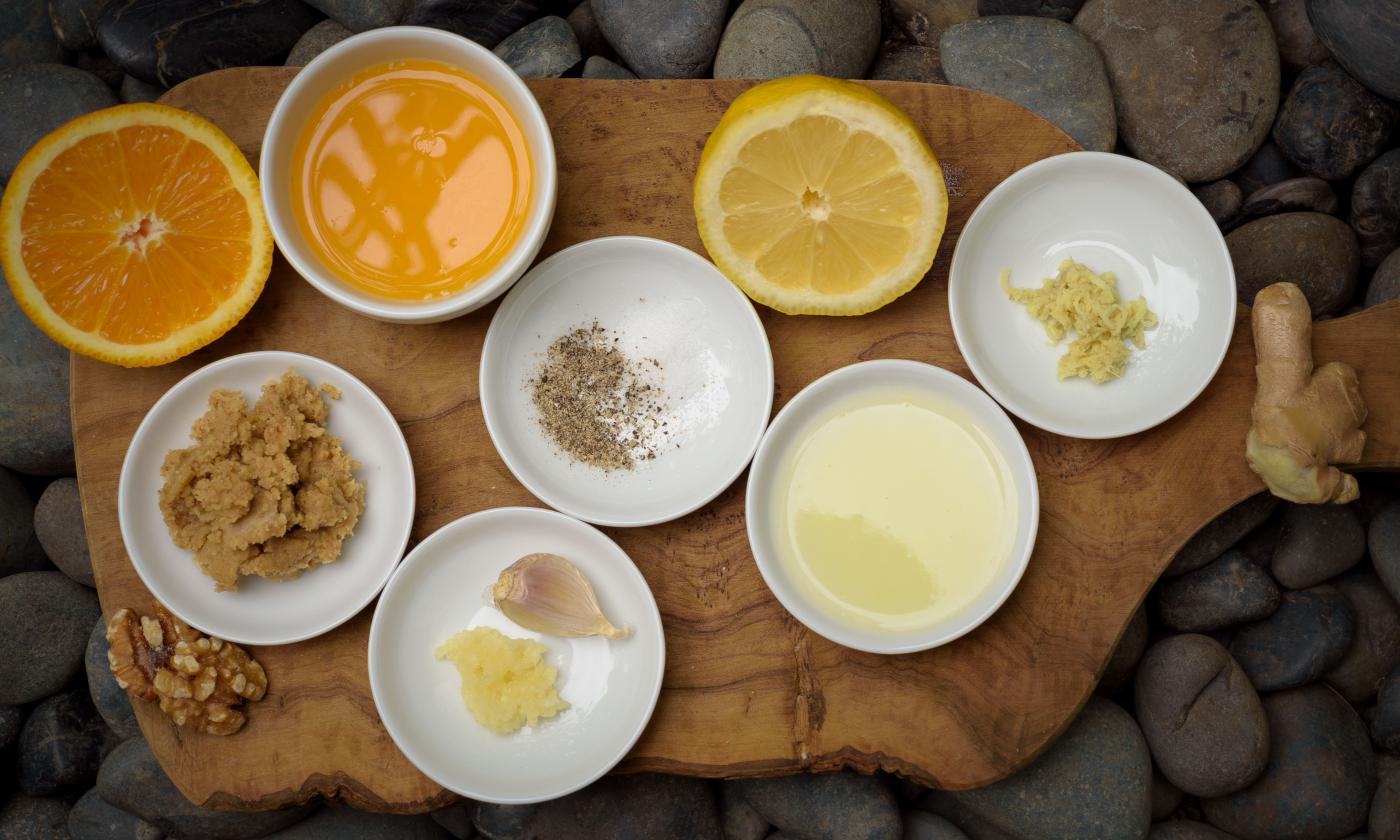Oil-free salad dressing (salad sauce) with walnuts
raw-vegan
Ingredients (for servings, )
| 2 ⅛ oz | Walnuts (tree nuts), raw (organic?) |
| 120 ml | Orange juice (raw?, organic?) (4.4 oz) |
| 3 tbsp | Lemon juice (raw?, organic?) (0.77 oz) |
| 1 clove | Garlic (organic?) (0.11 oz) |
| ½ TL, gerieben | Ginger, raw (organic?) (0.05 oz) |
| 1 dash | Table salt (table salt, raw?, organic?) (0.01 oz) |
| 1 dash | Black pepper (organic?, raw?) (0.00 oz) |
Equipment
- grater
- coffee grinder, electric
- citrus juicer (lemon squeezer)
Type of preparation
- chop or grind
- food preparation without heating
- blend
- squeeze
- grate (shred)
Preparation
Preparation
Grind the walnuts very finely in a coffee grinder until they become a puree. This may take three passes on the fine setting.Freshly squeeze oranges and lemons. Measure out the appropriate amounts of juice.
Balsamic vinegar: Alternatively, you can replace most of the orange juice with balsamic vinegar. See the recipe: Oil-free vinaigrette (salad dressing) with walnuts.
Peel and press the garlic. Peel the fresh ginger (optional) and grate finely.
Finish the salad dressing
Mix all ingredients together. Depending on the desired consistency, dilute a little more if necessary.
Season with salt and pepper as needed.If you leave it to stand for a longer period of time, the dressing will thicken a little more.
|
Nutritional Information per person
Convert per 100g
|
2000 kcal | |
|---|---|---|
| Energy | 77 kcal | 3.8% |
| Fat/Lipids | 6.6 g | 9.4% |
| Saturated Fats | 0.62 g | 3.1% |
| Carbohydrates (inc.dietary fiber) | 4.0 g | 1.5% |
| Sugars | 2.1 g | 2.4% |
| Fiber | 0.74 g | 3.0% |
| Protein/Albumin | 1.7 g | 3.4% |
| Cooking Salt (Na:26.4 mg) | 67 mg | 2.8% |
| Essential micronutrients with the highest proportions | per person | 2000 kcal | |
|---|---|---|---|
| Fat | Alpha-Linolenic acid; ALA; 18:3 omega-3 | 0.91 g | 46.0% |
| Fat | Linoleic acid; LA; 18:2 omega-6 | 3.8 g | 38.0% |
| Min | Manganese, Mn | 0.36 mg | 18.0% |
| Min | Copper, Cu | 0.17 mg | 17.0% |
| Vit | Vitamin C (ascorbic acid) | 12 mg | 15.0% |
| Vit | Folate, as the active form of folic acid (née vitamin B9 and | 17 µg | 8.0% |
| Prot | Tryptophan (Trp, W) | 0.02 g | 7.0% |
| Prot | Threonine (Thr, T) | 0.06 g | 7.0% |
| Vit | Biotin (ex vitamin B7, H) | 3.6 µg | 7.0% |
| Elem | Phosphorus, P | 39 mg | 6.0% |
Detailed Nutritional Information per Person for this Recipe
The majority of the nutritional information comes from the USDA (US Department of Agriculture). This means that the information for natural products is often incomplete or only given within broader categories, whereas in most cases products made from these have more complete information displayed.
If we take flaxseed, for example, the important essential amino acid ALA (omega-3) is only included in an overarching category whereas for flaxseed oil ALA is listed specifically. In time, we will be able to change this, but it will require a lot of work. An “i” appears behind ingredients that have been adjusted and an explanation appears when you hover over this symbol.
For Erb Muesli, the original calculations resulted in 48 % of the daily requirement of ALA — but with the correction, we see that the muesli actually covers >100 % of the necessary recommendation for the omega-3 fatty acid ALA. Our goal is to eventually be able to compare the nutritional value of our recipes with those that are used in conventional western lifestyles.
| Essential fatty acids | per person | 2000 kcal |
|---|---|---|
| Alpha-Linolenic acid; ALA; 18:3 omega-3 | 0.91 g | 46.0% |
| Linoleic acid; LA; 18:2 omega-6 | 3.8 g | 38.0% |
| Essential amino acids | per person | 2000 kcal |
|---|---|---|
| Tryptophan (Trp, W) | 0.02 g | 7.0% |
| Threonine (Thr, T) | 0.06 g | 7.0% |
| Isoleucine (Ile, I) | 0.06 g | 5.0% |
| Leucine (Leu, L) | 0.12 g | 5.0% |
| Phenylalanine (Phe, F) | 0.07 g | 5.0% |
| Valine (Val, V) | 0.08 g | 5.0% |
| Methionine (Met, M) | 0.02 g | 3.0% |
| Lysine (Lys, K) | 0.05 g | 2.0% |
| Vitamins | per person | 2000 kcal |
|---|---|---|
| Vitamin C (ascorbic acid) | 12 mg | 15.0% |
| Folate, as the active form of folic acid (née vitamin B9 and | 17 µg | 8.0% |
| Biotin (ex vitamin B7, H) | 3.6 µg | 7.0% |
| Thiamine (vitamin B1) | 0.06 mg | 5.0% |
| Vitamin B6 (pyridoxine) | 0.07 mg | 5.0% |
| Riboflavin (vitamin B2) | 0.02 mg | 2.0% |
| Pantothenic acid (vitamin B5) | 0.10 mg | 2.0% |
| Niacin (née vitamin B3) | 0.20 mg | 1.0% |
| Vitamin E, as a-TEs | 0.08 mg | 1.0% |
| Vitamin A, as RAE | 2.2 µg | < 0.1% |
| Vitamin K | 0.33 µg | < 0.1% |
| Essential macroelements (macronutrients) | per person | 2000 kcal |
|---|---|---|
| Phosphorus, P | 39 mg | 6.0% |
| Magnesium, Mg | 19 mg | 5.0% |
| Potassium, K | 93 mg | 5.0% |
| Sodium, Na | 26 mg | 3.0% |
| Calcium, Ca | 13 mg | 2.0% |
| Essential trace elements (micronutrients) | per person | 2000 kcal |
|---|---|---|
| Manganese, Mn | 0.36 mg | 18.0% |
| Copper, Cu | 0.17 mg | 17.0% |
| Zinc, Zn | 0.33 mg | 3.0% |
| Iron, Fe | 0.35 mg | 2.0% |
| Selenium, Se | 0.59 µg | 1.0% |
| Fluorine, F | 0.26 µg | < 0.1% |
| Iod, I (Jod, J) | 0.32 µg | < 0.1% |
Oil-free salad dressing with walnuts and orange juice tastes fresh and fruity. It has a good ratio of omega-6 to omega-3 fatty acids.
Serving size: The stated amount makes approximately 200 ml of salad dressing. This is enough for a large salad for 6 people.
Walnuts: In Central Europe, the common walnut ( Juglans regia) is particularly important. Of all known nuts, the walnut has the highest proportion of alpha-linolenic acid (ALA). The ratio of omega-6 to omega-3 fatty acids is 1:4, which is below the target maximum value of 1:5. The walnut also scores highly in terms of health thanks to tocopherols (forms of vitamin E) and many macro and trace elements.
Orange juice: Oranges, also known as tangerines, are the most widely grown citrus fruit in the world and one of the best-known sources of vitamin C. Orange juice extracted from the fruit by pressing accounts for up to 50% of the total consumption of all fruit juices.
Lemon juice: Raw lemon juice is often used when a drink or dish needs a sour, fresh taste. Thanks to its antioxidants, it also works against discoloration caused by oxygen. The pulp contains around 3.5-8% citric acid and a lot of vitamin C.
Ginger: Ginger has an aromatic smell and a sharp and spicy taste, which is primarily due to the ingredient gingerol, which is said to have anti-carcinogenic and anti-inflammatory effects. The substances borneol and cineol give ginger its digestive, stomach-strengthening, antiemetic (against nausea and vomiting), appetite-stimulating and circulation-stimulating properties. The rhizome of ginger is used in cooking and is used in fresh, dried or ground form. Green or young ginger refers to the young rhizomes, which have a milder taste.
LA:ALA ratio: With an LA:ALA ratio of 4.2:1, walnuts have the highest omega-3 content of all known nuts. Just 25 grams of walnuts cover your daily requirement of this fatty acid.
You can find further information on this topic at the following link: Vegans often eat unhealthily. Avoidable nutritional errors.
Reduce salt: Try to keep the salt content as low as possible. Although it takes around 3 months to get used to a lower salt content, you will also benefit from this change in terms of taste. You can find more information on this topic in the book Salt Sugar Fat by Michael Moss, which we describe in detail.
Spicy version: If you like it spicy, you can add chili - this harmonizes well with the fruity sweetness of the oranges.
Other sources of Omega-3: You can also replace walnuts with ground flaxseed (about 6 tablespoons, ground in a coffee grinder). This improves the LA:ALA ratio even further, but means that the dressing will thicken more quickly when left to stand. It also lacks the pleasant nutty taste.
Balsamic vinegar: Alternatively, you can replace most of the orange juice with balsamic vinegar. See the recipe: Oil-free vinaigrette (salad dressing) with walnuts.








